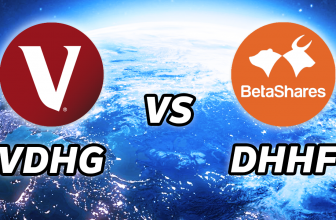With the huge growth in the technology sector in recent years, the demand for technology focussed ETFs has grown as well. In this post I’ll go through technology focussed ETFs on the ASX today. I’ll breakdown each ETF and show you their top holdings, what they actually focus on tracking, their management fees, whether or not they pay a dividend and of course their historical returns
For those who don’t know what an ETF is, it stands for Exchange traded fund. And in short its a simple way for you as an investor to easily buy a basket of stocks through just 1 stock ticker. Every ETF has an investment objective where they are usually trying to mirror the performance of a particular financial index. They are great for regular investors like you and I to easily diversify without needing to pay large amounts of brokerage buying hundreds of different stocks.
Thankfully for aussie investors seeking exposure to this sector, there’s now some ETFs available on the ASX that specifically target technology stocks. But before I start I’d like to quickly go through some of the pros and cons that Ive found when thinking about investing in technology
Pros and Cons of Technology Investing
- Pros
- Great Returns. The first pro and probably the main reason you’re interested in this post is the fact that technology shares have historically had great returns. If we look at their growth over the last 10 years compared to the total market you can see significant out performance. And whilst we all know this isn’t a guarantee of future performance it is still something to consider
- Tech stocks can pay dividends. Some of them anyway. There can be benefits to dividend-paying stocks that might include consistent earnings, and they might indicate that the company is positioned to deliver strong performance.
- You can actually buy shares in the stuff you use. Chances are, you probably use some tech in your daily routine. You might have a smartphone, a laptop, hop on a social network, or order some stuff online. With a tech stock, you can buy a little piece of the companies you know and like.
- You can diversify in tech! Tech stocks aren’t a monolith. You can add some diversity to your portfolio just by purchasing different aspects of the tech sector. For example, you could buy stock in social media companies, Microchip manufacturers, hardware makers, software companies, and even green tech companies.
- Cons
- Lack of industry diversification. However if you’re looking into tech ETFs you’re probably not seeking industry diversification
- Tech pull-back incoming? There are a few critics who believe increased regulation and government scrutiny could lead to a backlash against tech stocks that could affect their future prospects. But like many other sectors of the stock market, we will find that different tech stocks will react in different ways in the face of volatility.
- Buying what you know can be complicated. The master of investing himself Warren Buffet always says that he only buys shares in businesses that he can understand. You might have a solid grasp on some of the social media giants, for example, but some emerging technologies might be a little harder to wrap your head around. You may have to ask yourself if you want to invest in a company that you might not fully understand.
- Is it too late? Some tech companies, like Amazon and Google, have shares that are well into four figures, so it might feel like the ship has sailed for a first-time tech stock investor.
- Management fees. Because tech ETFs are somewhat of a niche in the ETF world compared they typically attract higher management fees on average, despite tracking indexes and not being actively managed.
5 Technology ETFs Available on the ASX Today
1. FANG
To get started the first ETF I’d like to show you is the FANG ETF
- Focus or index they are tracking
- The FANG+ ETF aims to provide investors with a return that tracks the performance of the NYSE®FANG+™ Index by investing in the shares that make up the index in proportion to their index weights. The index focuses on those companies representative of high growth technology or advanced technology driven sectors such as in the consumer discretionary on the major US stock exchanges.
- And it includes some of the top innovation leaders across today’s technology and tech-enabled companies. It is equally weighted across all companies and rebalanced quarterly.
- How many holdings
- This ETF is quite unique in that it only has 10 holdings
- Their fees
- The fees are 0.35% which are on the low side for tech ETFs
- Dividends
- They pay dividends twice a year with the last distribution having a 12 month yield of 0.98%
- Historical returns
- The etf is actually very new having only been listed on the ASX in Feb2020. From inception to July has already returned 22.94% which is quite impressive given the total market crash due to COVID-19. Its also good to note that the index this ETF is tracking has actually been around for a number of years and has returned over 20%pa in that time.
- My take
- Its not really what many would consider a true ETF due to its lack of diversification and holding only 10 stocks but if you are bullish on tech like me I think its a great pick. As most of these companies are what many would consider too big to fail with excellent balance sheets. With the only real danger being government regulation
2. TECH
To next ETF that I want to cover is aptly named TECH ETF
- Focus or index they are tracking
- TECH aims to provide investors with a return that tracks the performance of the Morningstar Developed Markets Technology Moat Focus Index. TECH uses a full-replication strategy to track the index, meaning that it holds all of the shares that make up the index closely in proportion to their index weights.
- The index comprises of 25 to 50 global technology companies across areas such as software, semi-conductors, data processing, computer equipment and databases. Companies are screened using Morningstar’s proprietary Moat methodology, to include only those companies that are identified as possessing strong competitive advantages relative to their peers. Further, companies are selected for the index on the basis of how attractively they are priced relative to their fair value
- How many holdings
- The TECH ETF currently has 35 holdings
- Their fees
- And the management fees are again relatively low for a tech etf at 0.45%
- Dividends
- A great feature of this ETF are the strong dividend returns. Dividends are paid semi-annually and the last distribution had a 12 month yield of 9.54%
- Historical returns
- On top of the great dividends the historical returns have been great. The ETF has been around for around 3 years and since inception has return 25.59%pa
- My take
- The TECH ETF is an extremely solid ETF with great diversification across the entire tech sector with global exposure. This index has very strict criteria on what it determines as companies with a MOAT, so these companies are likely to have strong long term growth due to their competitive advantages and monopolistic tendencies
3. HACK
The next ETF is the HACK ETF and is one that is specifically focussed on a sector within the technology industry
- Focus or index they are tracking
- So HACK aims to track the performance of an index that provides exposure to the leading companies in the global cybersecurity sector
- How many holdings
- HACK currently has 49 holdings
- Their fees
- The management costs for HACK are on the higher side at 0.67% but this is typical as you get more and more niche
- Dividends
- Dividends are paid out twice a year and its 12 month distribution yield is 8.2% which is great when coupled with its historical returns
- Historical returns
- The hack ETF has been around for almost 4 years and since inception has returned 19.97%pa which is pretty impressive given its niche nature and the fact that we’ve had 2 market downturns in that time
- My take
- My take on HACK is that its another great choice for exposure to the increasingly important cybersecurity sector. Its almost every day we hear something on the news about privacy concerns or a large company being hacked and this etf is full of companies solving these probelms
4. ASIA
The next ETF is one with a demographic focus that is the Asia Technology Tigers ETF or simply ASIA.
- Focus or index they are tracking
- ASIA aims to track the performance of an index comprised of the 50 largest technology and online retail stocks in Asia (excluding-Japan), including technology giants such as Alibaba, Tencent, Baidu and JD.com.
- How many holdings
- There are currently 56 holdings in ASIA
- Their fees
- Their management costs again are on the higher side at 0.67%
- Dividends
- With dividends being paid out annually. The 12 month distribution yield is 0.4%
- Historical returns
- The ETF listed towards the end of 2018 and since inception has returned 17.62%pa which isn’t as strong as some of the other ETFs I’ve talked about but what I would like to point out is ASIAs 1 year return of 42.65% and its relative resilience to the COVID market crash
- My take
- I think the ASIA ETF is a nice one to include in your portfolio if you believe in emerging markets and the strong technology adoption in these countries with great growth potential. It also provides good diversification with many companies that aren’t included in any of these other ETFs.
5. ATEC
The last ETF I’d like to talk to you guys about is a brand new ETF focussed on tech companies in Australia, that is ATEC
- Focus or index they are tracking
- ATEC aims to track the performance of the S&P/ASX All Technology Index . The Index provides exposure to leading ASX-listed companies in a range of tech-related market segments such as information technology, consumer electronics, online retail and medical technology.
- How many holdings
- ATEC currently has 51 holdings
- Their fees
- The management fees are not too bad at 0.48% but one thing you do have to consider given that all of these companies are listed on the ASX you could purchase the companies directly yourself if you want to go down that route.
- Dividends
- ATEC pays dividends out annually and because the etf was only listed in march they aren’t showing the 12 month yield on the website yet. However they did pay out a dividend of 27 cents a share in July which was at the price at the time provided a yield of roughly 1.5%
- Historical returns
- Because this ETF is so new its tough to talk much about historical returns but since inception it has returned 13.29% which is significantly better than the ASX200 in the same time period.
- My take
- I think ATEC is a nice one to have in the portfolio if you want to have an easy way to include Australian tech companies in your portfolio. However my main concern is that a lot of the companies included in this ETF aren’t really true technology companies, for example AfterPay, Carsales, REA Group, etf when compared to the likes of Facebook or Google. And they are more companies using technology to give them a competitive advantage in a particular industry such as finance or real estate.
I wanted to do a final note on one ETF that is very popular on the ASX and often used to gain tech exposure. And thats the Nasdaq 100 or NDQ ETF. Whilst this is a great ETF and one that I personally hold I’ve left it out because its not actually a pure technology etf and its more just by circumstance that the top 100 non financial companies in the Nasdaq are mainly filled with tech companies. Probably a good indicator that the tech sector is a good one to be invested in.
So those are the 5 ETF options on the ASX that I consider to be pure technology ETFs. As always do your own research before thinking about investing and let me know if the comments if you think there’s an ETF I might have missed or if you would like me to review other industry ETFs.






